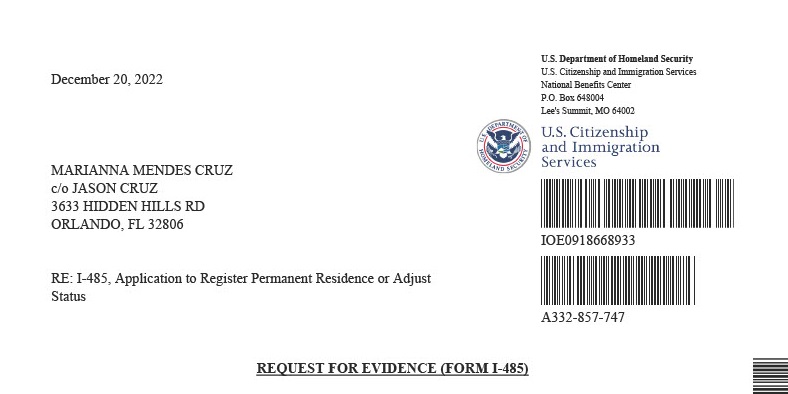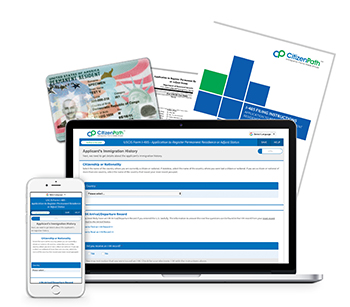USCIS Request for Evidence and How to Respond
Request for Evidence (RFE) Explained
What is an RFE?
U.S. Citizenship and Immigration Services (USCIS) may issue a Request For Evidence when an application or petition lacks necessary documentation or evidence to make a decision on the immigration benefit requested. If USCIS mails you a Request for Evidence, it means that they need you to provide additional proof before they can proceed with your application or petition. Once USCIS issues an RFE, the processing of your request stops; this can create a significant delay. When you respond to USCIS with the requested items (before the deadline), they will continue processing your application or petition.
Failing to respond to an RFE by the deadline will virtually guarantee that your application or petition gets denied. Therefore, responding to a Request for Evidence in an accurate and timely manner is critical for the success of your case. We suggest some guidelines for responding to an RFE and some tips for avoiding this dreaded request in the first place.

Most Common RFEs for Adjustment of Status
Why did USCIS send a Request for Evidence?
Take a deep breath. A Request for Evidence will delay your case processing time and may create some anxiety, but it isn’t an indicator of a pending denial. If you fail to respond, USCIS will likely deny your application. But if you respond as directed, you are no more likely to be denied than if you hadn’t gotten the RFE.
USCIS may issue a Request for Evidence for almost any immigration benefit. However, some of the most common RFEs issued for adjustment of status cases include:
Sponsor's support is insufficient to remove public charge ground
Family-based applications generally require you to prove that you are not inadmissible on the public charge ground. A common RFE related to I-485 applications is that applicants fail to include all the supporting documents necessary to document the sponsor's income. The sponsor must sufficiently evidence income and resources claimed on Form I-864, Affidavit of Support.Insufficient evidence of birth
USCIS has specific requirements for birth certificates. You generally must provide a long form birth certificate. Some countries don't have birth records that match USCIS expectations. When appropriate civil documents do not exist, you may need to submit alternative evidence. Learn more about submitting adequate evidence of birth for adjustment of status.Missing evidence of lawful entry
Evidence of legally entering the United States is almost always essential to adjust status to permanent resident. Failing to prove a lawful entry will likely lead to a denial. In most cases, applicants can provide a photocopy of Form I-94, Arrival/Departure Record, from their most recent entry to satisfy the requirement. It's simple to replace the I-94, and there are options when your I-94 is not correct.Lack of certified translation
If any of your supporting documents are in a foreign language, you must provide an English translation made by someone other than the petitioner or beneficiary. All translations must be in the form of a certified translation for USCIS.Missing initial evidence
Sometimes people just forget to include an important piece of evidence or include all pages of a form (even if the page is empty). USCIS, at its discretion, may deny applications that are incomplete. This is your opportunity to rectify the oversight by submitting the missing information.
You may have forgotten to answer a question, submit supplementary forms, or provide essential documents. Read the USCIS directions completely and carefully before filing forms. If you want the reassurance that you're doing everything correctly, use CitizenPath to prepare your application package. In addition to your correctly prepared form, CitizenPath provides you with a set of personalized filing instructions. Our filing instructions are customized to your answers in the application so you which supporting documents to submit for your specific situation. Learn more >>
Review Your RFE Carefully
What does my RFE say?
USCIS is providing you with a second chance to submit evidence. It's important that you understand exactly what you are supposed to do. You have one opportunity to respond to the RFE with the correct information and get your application back on track. USCIS tends to use many scripted responses in their RFE letters. As such, the letters may be vague. They are rarely precise about the missing evidence.
Identify the Requested Evidence
The letter will generally list all the additional documents that USCIS needs to make a decision on your application. USCIS may also explain which eligibility requirements have not been met by the documents already submitted. They may even list documents that you know you've already submitted. Immigration officials who adjudicate your case are human; they may have overlooked something. But it is likely you need to submit additional evidence to corroborate facts in your request. Regardless, identify each of the items of evidence that you need to submit to USCIS.
Identify the Deadline
The USCIS Request for Evidence will also provide a deadline. This tells you how long you have to respond. If you can, responding sooner is better. You will need to respond to the RFE before the deadline indicated so that the adjudicator will have enough evidence to make a favorable decision. If you fail to respond by the RFE deadline, USCIS will make a decision based on the existing evidence. Generally, that leads to a denial.
How to Respond to a USCIS Request for Evidence
How should I reply to the RFE?
Once you've identified the requested evidence and gathered it, you'll need to respond to the Request for Evidence within the allotted time frame.
Provide one complete response
USCIS generally issues only one RFE. You need to respond with a single response that thoroughly satisfies the request and supplies all evidence. If you fail to adequately respond, USCIS will likely deny your application. Address the issues as clearly as possible and provide your answers in one, single response. If you are uncomfortable responding to a Request for Evidence, seek assistance from an expert.
Organize your response
Make it easy for USCIS to understand your response by keeping it short and to the point. If the RFE is complex, include a table of contents or document your answer with exhibits. Although it is not mandatory, it's a good idea to include a cover letter that itemizes the evidence that you are submitting. The cover letter should be short and address the specific components of the RFE, so that you can show the USCIS officer handling your case that you provided all of the requested information. Include the RFE on top of your response and include the remaining items in the following order:
- Original RFE (must be on top)
- RFE cover letter (view an example)
- All requested evidence
Respond before the deadline
It should go without saying, but you must respond on time. Missing the deadline will most likely result in a denial. Don’t be late. Remember to make a copy of the RFE and all evidence for your own records. You'll need to return the original Request for Evidence with your response.
Mail the response package to the address specified on the RFE. Mail the package via U.S. Postal Service Priority Mail or a courier (e.g. FedEx, UPS or DHL) that can track your package. You want to have delivery confirmation so you have proof that you responded in the allowed time frame.
Tips to Avoid an RFE
How do I avoid RFEs?
USCIS issues a Request for Evidence when an applicant has not provided sufficient documentation or information in an original package. Therefore, preparing a complete and detailed application package is important for avoiding an RFE. In a similar way, irrelevant or unnecessary information can clutter an application package.
- Avoid inconsistencies and omissions of information. If there are any inconsistencies, explain them at the time of filing the application.
- Provide complete certified translations for evidence that is originally printed in a foreign language.
- Use evidence with more probative value when possible.
- When scanning or making photocopies, ensure that you get a clean image so that all important details can be read.
- Organize your application package in a way that it’s easy for USCIS to locate and identify evidence.
CitizenPath.com can help you prepare USCIS immigration forms and avoid a Request for Evidence. Immigration attorneys designed the affordable service to provide simple, step-by-step assistance for USCIS applications and petitions. CitizenPath provides an instant warning if your answer to a question could be problematic. We’ll also make certain that your request is complete. In fact, we guarantee that USCIS will approve your form.
What’s more, the service includes a set of personalized filing instructions with examples of evidence to submit. CitizenPath customizes the filing instructions based on your specific case. So you will know exactly which documents to submit with the application and where to mail it.
CitizenPath’s self-directed software is even free to get started. If you’re not eligible or if we find a problem, you can stop at any time. No payment is required until you reach the end of the application. See CitizenPath's immigration services >>
NOID is Different than RFE
Is a NOID the same as an RFE?
A Notice of Intent to Deny (NOID) is much more serious than a Request for Evidence. A NOID is a negative determination and impending denial. It is a formal warning that a USCIS officer reviewed your case and plans to deny it if you are unable to provide more convincing evidence. You should take urgent action, generally with the assistance of an immigration attorney, to address the NOID with stronger evidence of your eligibility for the immigration benefit.
How CitizenPath Helps You Avoid an RFE
How do I avoid a Request for Evidence?
Filing USCIS forms is not a fill-in-the-blank exercise. You need evidence to corroborate the facts stated in your USCIS application or petition.
Each benefit request has specific eligibility requirements that a requestor must meet. Supporting documents are the evidence you need to establish eligibility. You may not need a lawyer, but you need a partner like CitizenPath to help ensure you submit a complete application package with all the right evidence.
CitizenPath's affordable, online service makes it easy to prepare USCIS applications and petitions. Designed by immigration lawyers, the service helps you eliminate the common errors that create delays, rejections and even denials. That's because the service alerts you when your answer to a question may be a problem. You'll also get customized filing instructions based on your situation. It's a powerful, do-it-yourself tool that puts you in control. And we've got your back -- CitizenPath provides live customer support and provides a money-back guarantee that USCIS will approve the form.

